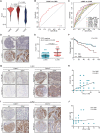Identification of adenoid subtype characterized with immune-escaped phenotype in lung squamous carcinoma based on transcriptomics
- PMID: 36224612
- PMCID: PMC9555124
- DOI: 10.1186/s40164-022-00327-5
Identification of adenoid subtype characterized with immune-escaped phenotype in lung squamous carcinoma based on transcriptomics
Abstract
Non-small cell lung cancer (NSCLC) is a heterogeneous disease, and its demarcation contributes to various therapeutic outcomes. However, a small subset of tumors shows different molecular features that are in contradiction with pathological classification. Unsupervised clustering was performed to subtype NSCLC using the transcriptome data from the TCGA database. Next, immune microenvironment features of lung adenocarcinoma (LUAD), lung squamous carcinoma (LUSC), and lung adenoid squamous carcinoma (LASC) were characterized. In addition, diagnostic biomarkers to demarcate LASC among LUSC were screened using weighted gene co-expression network analysis (WGCNA) and validated by the in-house cohort. LASC was identified as a novel subtype with adenoid transcriptomic features in LUSC, which exhibited the most immuno-escaped phenotype among all NSCLC subtypes. In addition, FOLR1 was identified as a biomarker for LASC discrimination using the WGCNA analysis, and its diagnostic value was validated by the in-house cohort. Moreover, FOLR1 was related to immuno-escaped tumors in LUSC but not in LUAD. Overall, we proposed a novel typing strategy in NSCLC and identified FOLR1 as a biomarker for LASC discrimination.
Keywords: Biomarker; Immuno-escaped; NSCLC; Subtype.
© 2022. The Author(s).
Conflict of interest statement
There are no competing interests.
Figures


Similar articles
-
Telomere-associated genes and telomeric lncRNAs are biomarker candidates in lung squamous cell carcinoma (LUSC).Exp Mol Pathol. 2020 Feb;112:104354. doi: 10.1016/j.yexmp.2019.104354. Epub 2019 Dec 16. Exp Mol Pathol. 2020. PMID: 31837325
-
LINC00628 is differentially expressed between lung adenocarcinoma and squamous cell carcinoma and is associated with the prognosis of NSCLC.Oncol Lett. 2022 Feb;23(2):55. doi: 10.3892/ol.2021.13173. Epub 2021 Dec 21. Oncol Lett. 2022. PMID: 34992687 Free PMC article.
-
A prognosis-related molecular subtype for early-stage non-small lung cell carcinoma by multi-omics integration analysis.BMC Cancer. 2021 Feb 6;21(1):128. doi: 10.1186/s12885-021-07846-0. BMC Cancer. 2021. PMID: 33549049 Free PMC article.
-
Bioinformatics analysis of differentially expressed miRNAs in non-small cell lung cancer.J Clin Lab Anal. 2021 Feb;35(2):e23588. doi: 10.1002/jcla.23588. Epub 2020 Sep 23. J Clin Lab Anal. 2021. PMID: 32965722 Free PMC article.
-
The Effect of GLUT1 on the Survival Rate and Immune Cell Infiltration of Lung Adenocarcinoma and Squamous Cell Carcinoma: A Meta and Bioinformatics Analysis.Anticancer Agents Med Chem. 2022;22(2):223-238. doi: 10.2174/1871520621666210708115406. Anticancer Agents Med Chem. 2022. PMID: 34238200 Review.
References
Publication types
Grants and funding
LinkOut - more resources
Full Text Sources

